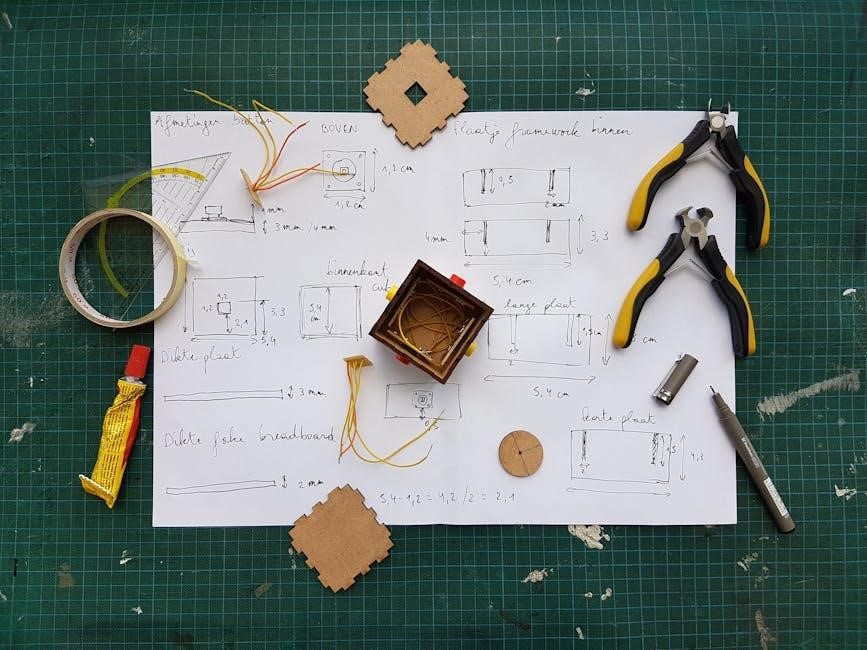The Crosman 760 Pumpmaster is a versatile pneumatic BB/pellet air rifle known for its durability and ease of use‚ ideal for target shooting and pest control scenarios․
1․1 Overview of the Crosman 760 Pumpmaster
The Crosman 760 Pumpmaster is a classic‚ reliable pneumatic air rifle designed for versatility․ It shoots both ․177 caliber pellets and 4․5mm BBs‚ making it ideal for target shooting and small pest control․ Known for its durability and user-friendly design‚ this air rifle is a favorite among both beginners and seasoned shooters‚ offering adjustable power levels and a straightforward operation mechanism․
1․2 Importance of the Owner’s Manual
The owner’s manual is crucial for understanding the Crosman 760 Pumpmaster’s operation‚ safety‚ and maintenance․ It provides detailed instructions for assembling‚ loading‚ and firing‚ ensuring safe and effective use․ The manual also covers troubleshooting and routine maintenance tips‚ helping users maximize the rifle’s performance and longevity․ Adhering to the guidelines in the manual is essential for optimal functionality and user safety․
Safety Precautions and Warnings
Always follow safety guidelines to avoid accidents․ Keep the rifle pointed away from people and ensure the safety is engaged․ Wear eye protection and store the rifle unloaded and securely․
2․1 General Safety Guidelines
Always treat the 760 Pumpmaster as a firearm․ Keep the muzzle pointed away from people and animals․ Ensure the manual safety is engaged when not firing․ Wear protective eyewear during use․ Never leave the air rifle loaded or unattended‚ especially near children․ Store the rifle securely in a dry place․ Use only Crosman-approved pellets or BBs to avoid damage․ Never modify the rifle beyond factory specifications․
2․2 Proper Handling and Storage
Handle the 760 Pumpmaster with care to avoid accidental discharge․ Store the air rifle unloaded in a dry‚ cool place away from children․ Use a soft cloth to wipe down the exterior regularly․ Avoid exposing the rifle to extreme temperatures or moisture․ Keep the muzzle clear of obstructions and ensure all parts are securely tightened before use; Always follow Crosman’s storage guidelines to maintain functionality and safety․
Assembly and Parts Identification
The Crosman 760 Pumpmaster requires minimal assembly‚ focusing on attaching the stock and pump handle․ Key components include the receiver‚ barrel‚ and trigger mechanism‚ ensuring proper functionality and safety․
3․1 Key Components of the 760 Pumpmaster
The Crosman 760 Pumpmaster features a durable design with essential components like the receiver‚ bolt‚ and barrel․ The pump handle and forearm are crucial for cocking‚ while the trigger assembly and safety ensure controlled firing․ The rear sight allows elevation adjustments‚ and the stock provides a stable shooting platform․ Understanding these parts is vital for proper assembly‚ maintenance‚ and safe operation of the air rifle․
3․2 Assembly Instructions
Attach the pump handle to the receiver and align the bolt properly․ Secure the stock firmly to ensure stability․ Follow the manual’s guidance for correct assembly order to ensure all components function seamlessly․ Refer to the official Crosman manual for detailed diagrams and step-by-step instructions to assemble your 760 Pumpmaster accurately and safely․
Loading and Firing Instructions
Load BBs by opening the latch and pouring into the port․ For pellets‚ insert one into the bolt and close․ Pump 2-10 times‚ aim carefully‚ and fire with the safety off‚ ensuring proper technique for accuracy and safety․
4․1 Loading BBs and Pellets
For BBs‚ open the loading port‚ pour in‚ and close securely․ For pellets‚ insert one into the bolt‚ ensure it’s seated‚ then close․ Always clear BBs before loading pellets to prevent jamming․ Use 4․5mm BBs or ․177 pellets․ Follow manual instructions to avoid malfunctions and ensure safe operation․ Proper loading is crucial for reliable performance and accuracy․
4․2 Firing Techniques and Safety
Ensure the safety is off before firing․ Pump the rifle 2-10 times for desired power․ Aim carefully‚ squeezing the trigger smoothly․ Avoid firing with less than two pumps to prevent damage․ Always wear eye protection and maintain control․ Keep the muzzle pointed away from people and pets․ Follow all safety guidelines in the manual to ensure safe and effective operation of the 760 Pumpmaster․

Maintenance and Troubleshooting
Regular maintenance ensures optimal performance․ Clean the barrel and check seals for wear․ Lubricate moving parts and inspect for damage․ Address issues promptly to prevent malfunctions and extend lifespan․
5․1 Routine Maintenance Tips
Regularly inspect and clean the barrel to remove dirt and debris․ Apply silicone-based lubricant to moving parts to ensure smooth operation․ Check seals and O-rings for wear and replace as needed․ Store the rifle in a dry place to prevent rust․ Follow the manual’s guidelines for lubrication and maintenance to maintain performance and extend the lifespan of your Pumpmaster․
5․2 Common Issues and Solutions
Common issues include air leaks‚ jammed BBs‚ and reduced power․ Inspect and replace worn O-rings or seals to fix leaks․ Clear jams by removing the magazine and checking the loading port․ Ensure proper pumping techniques to maintain consistent power․ Refer to the manual for troubleshooting guides and solutions to restore optimal performance and extend the rifle’s lifespan․

Accessories and Upgrades
The Crosman 760 Pumpmaster supports various accessories like scopes‚ slings‚ and upgraded stocks for enhanced performance․ Official Crosman parts ensure compatibility and durability‚ maintaining the rifle’s versatility and reliability․
6․1 Recommended Accessories
The Crosman 760 Pumpmaster can be enhanced with a variety of accessories‚ including scopes for improved accuracy‚ slings for easier carrying‚ and upgraded stocks for better ergonomics․ Additional accessories like pellet holders‚ cleaning kits‚ and muzzle brakes are also available to improve performance and longevity․ Always refer to the official Crosman manual for compatible options to ensure safety and functionality․
6․2 Upgrading and Customizing the 760 Pumpmaster
Upgrading the Crosman 760 Pumpmaster can enhance performance and personalization․ Popular upgrades include high-quality scopes‚ slings‚ and customized stocks for improved ergonomics․ Internal modifications‚ such as valve tweaks or piston adjustments‚ can boost power and accuracy․ DIY kits and expert solutions are available for enthusiasts․ However‚ modifications should be done cautiously to avoid voiding the warranty or causing damage to the air rifle․
Understanding the Pumpmaster Mechanism
The Pumpmaster operates via a pneumatic system‚ requiring multiple pumps to increase air pressure and velocity․ Its reliable design ensures consistent performance when following manual guidelines․
7․1 How the Pump Action Works
The Pumpmaster’s pump action compresses air in the chamber with each stroke․ A minimum of two pumps is required for operation‚ with up to ten pumps for maximum velocity․ After pumping‚ the forend is released to ready the rifle for firing․ This mechanism ensures consistent power and accuracy when properly executed according to the manual’s guidelines․
7․2 Adjusting the Power and Accuracy
The Crosman 760 Pumpmaster allows for power adjustment by varying the number of pumps (2-10)․ Accuracy is refined by adjusting the rear sight elevator and aligning the front sight․ Proper pellet selection and consistent pumping technique further enhance precision․ Follow the manual’s guidelines to optimize performance and ensure safe‚ effective operation of the air rifle․

Target Shooting and Hunting Tips
The Crosman 760 Pumpmaster excels in target shooting and small game hunting‚ offering precise accuracy and controlled power․ Its versatility ensures effective performance in various shooting scenarios․
8․1 Aiming and Firing Techniques
For accurate shooting‚ align the front and rear sights with your target․ Adjust the rear sight for elevation by moving the elevator․ Pump the rifle 2-10 times for optimal power․ Hold firmly‚ squeeze the trigger smoothly‚ and avoid jerking․ Always maintain proper posture and eye alignment for consistent results․ This technique ensures precision in both target shooting and pest control scenarios․
8․2 Using the 760 Pumpmaster for Pest Control
The Crosman 760 Pumpmaster excels in pest control due to its accuracy and versatility․ Use ․177 caliber pellets for effective results on small pests․ Ensure safe shooting distances and avoid ricochets․ Pump 6-8 times for optimal power․ Always aim for a clean shot to minimize suffering․ Its reliability makes it a top choice for controlling pests in various outdoor settings․

Historical Background and Popularity
The Crosman 760 Pumpmaster‚ introduced in 1966‚ has become a legendary air rifle due to its reliability‚ versatility‚ and affordability‚ making it a favorite among shooters for decades․
9․1 History of the Crosman 760 Model
The Crosman 760 Pumpmaster was first introduced in the 1960s‚ quickly becoming a popular choice for target shooting and small game hunting․ Known for its durability and affordability‚ the 760 has remained in production for over five decades․ Its classic design and versatility in shooting both BBs and pellets have solidified its place as a timeless favorite among airgun enthusiasts of all skill levels․
9․2 Why the 760 Pumpmaster is a Favorite Among Shooters
The Crosman 760 Pumpmaster is a favorite due to its reliability‚ durability‚ and versatility․ Its ability to shoot both BBs and pellets makes it adaptable for various shooting needs․ The pump-action mechanism is simple to use‚ and its affordability makes it accessible to shooters of all skill levels․ Its classic design and consistent performance have made it a trusted choice for target shooting and pest control for decades․

Parts Diagram and Technical Specifications
The Crosman 760 Pumpmaster manual includes an exploded parts diagram and detailed technical specifications‚ such as the smooth bore barrel and ․177 caliber‚ ensuring proper assembly and maintenance․
10․1 Exploded View of the 760 Pumpmaster
The Crosman 760 Pumpmaster manual provides a detailed exploded view diagram‚ illustrating the air rifle’s components‚ such as the receiver‚ barrel‚ pump assembly‚ and trigger mechanism․ This visual guide helps users identify and understand each part’s location and function‚ aiding in proper assembly‚ maintenance‚ and repairs․ The diagram is essential for diagnosing issues and ensuring correct reassembly after disassembly‚ preventing potential damage to the airgun․
10․2 Technical Specifications and Dimensions
The Crosman 760 Pumpmaster is a ․177 caliber pneumatic air rifle‚ compatible with both BBs and pellets․ It features a smooth bore barrel and a plastic receiver․ The air rifle measures 33․5 inches in length and weighs approximately 4․5 pounds․ The stock is made of durable polymer‚ and the rifle includes a manual safety․ It is powered by a multi-pump pneumatic system‚ requiring at least two pumps to operate safely․ The 760 is backed by a one-year limited warranty․

Common Repairs and Modifications
Common repairs include fixing air leaks and replacing seals‚ while modifications often involve upgrading the pump and trigger for enhanced performance and accuracy in the Crosman 760 Pumpmaster․
11․1 DIY Repairs for Common Issues
DIY repairs for the Crosman 760 Pumpmaster often involve replacing worn-out seals and O-rings to fix air leaks․ Users can also clean the barrel and valve area to maintain performance․ Additionally‚ lubricating the pump mechanism with silicone-based oil can ensure smooth operation․ These simple fixes can extend the rifle’s lifespan and keep it functioning optimally without professional assistance․
11․2 Popular Modifications for Enhanced Performance
Popular modifications for the 760 Pumpmaster include upgrading the valve and hammer for increased power and accuracy․ Installing a steel breech enhances durability and allows for scope mounting․ Some users also modify the pump tube and piston for smoother operation and reduced friction․ These enhancements can significantly improve the rifle’s performance‚ making it more versatile for both recreational and competitive shooting․

Comparisons with Other Air Rifles
The Crosman 760 Pumpmaster stands out for its versatility‚ shooting both BBs and pellets‚ unlike many single-caliber air rifles‚ making it a favorite for its adaptability and reliability․
12;1 How the 760 Pumpmaster Stacks Up Against Competitors
The Crosman 760 Pumpmaster excels with its dual BB and pellet capability‚ offering versatility competitors often lack․ Its pneumatic design ensures consistent power with minimal maintenance‚ making it a durable choice for both beginners and seasoned shooters․ Compared to other air rifles‚ the 760 Pumpmaster’s classic design and ease of use solidify its reputation as a reliable and cost-effective option․
12․2 Unique Features of the 760 Pumpmaster
The Crosman 760 Pumpmaster stands out with its ability to shoot both BBs and pellets‚ offering unmatched versatility․ Its adjustable power levels‚ achieved through a variable pump action‚ provide flexibility for different shooting scenarios․ The rifle also features a durable‚ lightweight design and a manual safety for enhanced control․ These unique attributes make it a popular choice for target shooting and pest control․

User Reviews and Feedback
The Crosman 760 Pumpmaster is highly praised by users for its reliability‚ ease of use‚ and versatility․ A favorite among both beginners and experienced shooters․
13․1 Customer Satisfaction and Experiences
Customers praise the Crosman 760 Pumpmaster for its reliability and durability․ Many highlight its classic design and ease of use‚ making it a favorite for both beginners and experienced shooters․ Its versatility in shooting BBs and pellets adds to its popularity․ Users appreciate the detailed manual‚ which ensures optimal performance and safety‚ enhancing their overall satisfaction with the air rifle․
13․2 Tips from Seasoned Users
Seasoned users recommend proper pumping techniques‚ emphasizing at least 3-4 pumps for optimal power․ Regular maintenance‚ like lubricating seals‚ ensures longevity․ Using high-quality pellets and BBs enhances accuracy․ Always follow safety guidelines and store the rifle unloaded․ These tips‚ shared by experienced shooters‚ help maximize performance and extend the life of the Crosman 760 Pumpmaster․
The Crosman 760 Pumpmaster is a reliable and versatile air rifle‚ offering great performance for both beginners and seasoned shooters․ Regular maintenance ensures optimal functionality and longevity‚ making it a trusted choice for target shooting and pest control․ Adhering to the manual’s guidelines will enhance your overall experience․
14․1 Summary of Key Points
The Crosman 760 Pumpmaster stands out as a durable‚ versatile air rifle suitable for target shooting and pest control․ It operates with both BBs and pellets‚ offering adjustable power levels․ Proper assembly‚ loading‚ and maintenance are crucial for optimal performance․ Adhering to safety guidelines and manual instructions ensures longevity and safe operation․ This air rifle is a favorite among shooters due to its reliability and ease of use․
14․2 Final Recommendations for Owners
Always follow the manual’s safety guidelines and maintenance tips to ensure optimal performance․ Regularly inspect and clean the rifle to prevent damage․ Store the Pumpmaster unloaded and out of reach of children․ Use Crosman-approved accessories for compatibility․ Practice proper shooting techniques to enhance accuracy․ For troubleshooting‚ refer to the manual or contact Crosman support․ Proper care ensures years of reliable service and enjoyable shooting experiences․

References and Additional Resources
Refer to Crosman’s official website for the 760 Pumpmaster Manual and parts diagrams․ Visit online forums and communities for troubleshooting tips and user experiences with the air rifle․
15․1 Official Crosman Documentation
The official Crosman website provides the 760 Pumpmaster Manual (Part number 760KBA515) and detailed parts diagrams․ These resources offer comprehensive guidance on safe operation‚ maintenance‚ and troubleshooting․ Users can also contact Crosman directly at 1-800-724-7486 or visit www․crosman․com for additional support and documentation․ The manual is essential for understanding the air rifle’s features and ensuring optimal performance․
15․2 Online Communities and Forums
Online communities and forums‚ such as those found on CNEWS and dedicated airgun platforms‚ provide valuable resources for 760 Pumpmaster owners․ These forums offer tips‚ repair guides‚ and user experiences‚ allowing shooters to share knowledge and troubleshoot issues․ Websites like Pyramyd Air and other airgun forums also host discussions on modifications‚ maintenance‚ and upgrades‚ making them indispensable for enthusiasts seeking to enhance their air rifle’s performance and longevity․




















